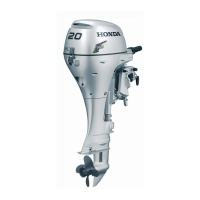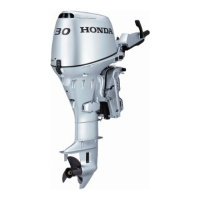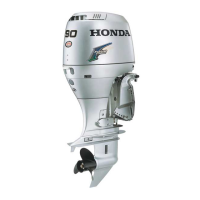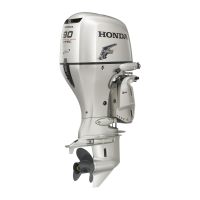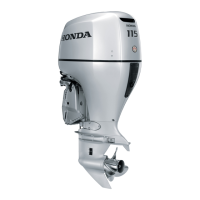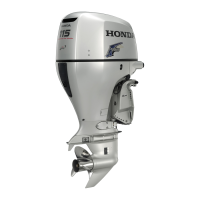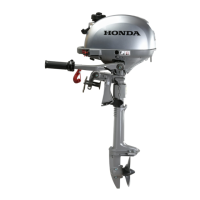Do you have a question about the Honda Marine BF9.9D and is the answer not in the manual?
Provides essential safety information for operating the outboard motor safely.
Identifies the location of important safety labels on the outboard motor.
Explains the coding system used to identify outboard motor model features and types.
Illustrates the locations of various components and controls on the outboard motor.
Details controls for the H Type tiller handle model, including engine stop, choke, throttle, and gearshift.
Details controls for the R Type remote control model, including ignition, emergency stop, and throttle levers.
Describes common controls found on various outboard motor types, such as engine cover latch and transom angle adjustment.
Explains the function of instruments like the fuel gauge and tachometer.
Describes various indicators such as oil pressure and overheat indicators.
Details additional features like the overrev limiter and automatic choke.
Specifies the required horsepower and checks for outboard motor installation.
Details the transom thickness specifications for installing Honda outboard motors.
Guides on the correct placement of the outboard motor on the boat transom for optimal performance.
Provides instructions on how to attach the outboard motor to the boat transom.
Explains how to adjust the transom angle for proper propeller operation.
Details the procedures for connecting the battery to the outboard motor for power.
Covers pre-operation checks and knowledge required for safe boating.
Emphasizes the importance of pre-operation inspections for safety and equipment service life.
Outlines crucial safety measures to follow during outboard motor operation.
Details the recommended break-in procedure for new outboard motors to ensure longevity.
Explains how to adjust the transom angle for optimal operation and performance.
Instructions for using and securing the portable fuel tank.
Guides on how to properly connect the fuel hose between the tank and the motor.
Explains the process of priming the fuel system before starting the engine.
Provides step-by-step instructions for starting the outboard motor, for both H and R types.
Details procedures for both normal and emergency engine stopping.
Explains how to operate the gearshift and throttle controls for optimal performance.
Describes how to steer the boat using the tiller handle or remote control.
Provides guidance on engine speed, transom angle, and handling rough conditions while cruising.
Instructions for operating the motor in shallow water to avoid damage.
Guidance on how to safely moor, beach, and launch the boat with the outboard motor.
Highlights the essential role of good maintenance for safe and economical operation.
Outlines critical safety precautions to follow during maintenance procedures.
Lists the tools supplied with the motor and the emergency starter rope.
Provides a detailed schedule for regular inspection and maintenance tasks.
Provides step-by-step instructions for removing and installing the engine cover.
Details how to check the engine oil level correctly.
Step-by-step guide for changing the engine oil, including disposal instructions.
Instructions on how to inspect and replace the oil filter.
Recommends specific SAE viscosity grades and API service classifications for engine oil.
Details how to check the gear oil level.
Provides instructions for changing the gear oil.
Identifies points requiring lubrication and the recommended interval.
Details how to inspect, gap, and replace spark plugs.
Provides instructions and safety precautions for refueling the outboard motor.
Recommends unleaded gasoline with a specific octane rating.
Instructions for inspecting and replacing the fuel filter.
Guidance on cleaning the portable fuel tank and filter.
Instructions for inspecting the recoil starter rope.
Details when and how to replace anodes to prevent corrosion.
How to adjust the friction for the choke knob to maintain its position.
Step-by-step guide for replacing the propeller, including safety precautions.
Steps to prepare the outboard motor for storage to prevent damage.
Instructions for cleaning and flushing the motor with fresh water.
Guidance on fuel storage, including deterioration and gumming issues.
How to add fuel stabilizer to extend fuel storage life.
Procedure for draining the fuel tank and carburetors for storage.
General precautions for selecting a storage area.
Instructions on how to prepare the motor after it has been stored.
Guidance for transporting the boat with the outboard motor attached.
Instructions for safely transporting the outboard motor when removed from the boat.
Troubleshooting steps for when the electric starter fails to operate.
Diagnoses and corrections for common reasons why the engine fails to start.
Troubleshooting tips for engines that are difficult to start or stall after starting.
Diagnoses and solutions for engine overheating issues.
Troubleshooting for battery charging and electric starter issues, including fuse replacement.
Explains issues related to low oil pressure and engine speed limitations.
Details engine overheating and its effect on engine speed, including indicator lights.
Instructions for servicing an outboard motor that has been submerged in water.
Locates the product identification and engine serial numbers for record-keeping.
Discusses modifications needed for optimal engine performance at high altitudes.
Information on using oxygenated fuels and their effects on the fuel system.
Details about emission control systems, regulations, and tampering.
Explains the meaning and significance of the Star Label for cleaner marine engines.
Provides detailed technical specifications for various Honda outboard motor models.
Outlines the terms, conditions, and coverage of the limited warranty.
Details the warranty coverage for the engine's emission control system.
| Lubrication | Wet Sump |
|---|---|
| Max Output | 9.9 hp |
| Full Throttle RPM Range | 5000 - 6000 rpm |
| Fuel Induction System | Carburetor |
| Starting System | Manual / Electric |
| Weight | 42 kg |
| Alternator | 6A (12V) |
| Cooling System | Water Cooled |
| Ignition System | CDI |
| Exhaust | Through propeller |
| Fuel | Unleaded gasoline |
| Propeller | 3-Blade |
| Tiller Handle | Yes |
| Power Trim | No |
| Engine Type | 4-stroke |


